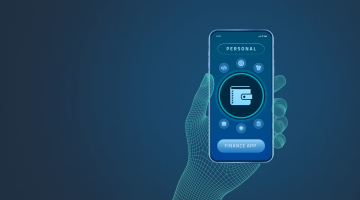

EHR software development: Full guide for 2024
The healthcare industry is an ambiguous realm that magically combines innovative treatment with legacy software. Even in developed countries, hospitals often fail to provide digital interactions. However, electronic medical records are already typical for healthcare facilities. According to the Medical Economics study, 86% of respondents have electronic health records (EHR) software systems with an average usage length of 7 years. This marks a relatively long history.
At DICEUS, we also have rich experience in healthcare software development and implementation. We created this guide for customers who want to update their existing EHR/EMR solutions or get brand-new ones. Let’s talk about modern healthcare issues, the benefits of electronic records, and the development stages.
Need to develop or update your EHR software? Here’s what we offer.
Current EHR-related challenges in healthcare
Despite the gradually growing market for electronic health records, which can reach $40 billion in 2024, the industry faces numerous challenges. Hospitals and patients aren’t completely satisfied with the new software, and regulators demand full compliance. Thus, developers must continually improve user experience and security.
The Medical Records survey also shows that 45% of physicians think that implementing electronic medical records has harmed the quality of services. Moreover, 50% of respondents say the staff’s attitude to EHRs is negative! This is evident because hospitals in many countries are obliged to install an EMR solution without proper customization. As a result, we see critical issues topped with time-consuming operations related to unnecessary data.
Another survey handled by Deloitte also spotted some weaknesses in EHR systems. Doctors in the USA mention these challenges:
- Complicated data entry
- Lack of mobile support
- Poor interoperability
- No custom reports
- Poor or no automation features
- Poor support of workflow management
We can also add cybersecurity issues that affect EHR apps’ reliability and potential regulative challenges, such as GDPR/HIPAA compliance.
However, the challenges also stimulate growth. We see more tailored EMR software that meets end-user demands. What are the basic functions of an EHR system that address the above-mentioned challenges and meet healthcare providers’ demands?
Do you have any challenges with legacy systems? We can help you.
Why is an EHR system necessary?
Electronic Health Records software is a powerful tool that maximizes a medical facility’s efficiency and productivity in the following aspects of its pipeline routine:
- Health information storage. The system is a repository of various clinical data, including patients’ lab test results, medical histories, medications, allergies, immunizations, and more, that can be easily retrieved and analyzed.
- Administrative workflows. The software is honed to streamline and facilitate hospital shop floor operations, such as scheduling, time management, patient outreach, billing, and more.
- Communication and connectivity. The messaging mechanism EHRs are equipped with allows them to guarantee prompt and secure communication between healthcare service providers and consumers.
- Result management and interoperability. Clinicians use an EHR to share lab test results and other information with their colleagues, thus coordinating their efforts in providing patient treatment and care. It is also essential that several EHR systems can exchange data with each other.
- Decision support. The notification functionality of EHR enables adhering to the best clinical practices, conducting regular screening, and implementing other preventative measures that enhance clinical decision-making and mitigate risks of chronic diseases.
- Order management. Thanks to EHR, clinicians can upload and store various orders (for tests, prescriptions, and more), thus ruling out duplication, enhancing legibility, and increasing the speed of order execution across multiple settings.
- Patient support. The patient portal of EHR enables healthcare service consumers to access their medical dossiers, conduct self-testing, improve in-home monitoring, review educational material, and more.
- Assessing the quality of services. Special analytics tools and reporting functionalities of EHR systems allow healthcare facilities to collect and process patients’ feedback. Its analysis offers insights that can be used as guidelines for improving the clinic’s services.
Now you realize how a high-end EHR can revolutionize the performance of your healthcare facility. Let’s find out how to get one for your business!
Electronic records 101
Talking about progress and EHR software development, we can’t skip the first point. Generally, electronic records are digital forms that contain some information. In other words, they are digital alternatives to regular paper documents. Hence, electronic medical/health records include patient information, e.g., demographics, medical history, lab tests, images, allergies, drugs, billing, and personal data.
As long as this guide is dedicated to healthcare-related records, it focuses on this industry only. But even one market has significant contrasts.
Difference between EHR and EMR
The most crucial difference lies between electronic medical records (EMR) and electronic health records (EHR). Here’s a brief explanation:
- EMR. It’s a personal record that contains information about a patient, including his/her general information, diagnosis, and treatments. EMRs are intended for one disease or one practice only. They don’t support third-party integrations and can’t be shared with other doctors/clinics. Still, they allow constant monitoring of patients and quick reactions. The best analogy with an EMR is a student card accepted in one school only.
- EHR. This record is way more functional. It includes more data that provides a complete picture of each patient’s condition. What’s more important is that EHRs can be shared between different doctors, healthcare facilities, and providers. Patients can use their EHRs in any clinic or laboratory, even in other cities and—sometimes—countries. Continuing our analogy, an EHR is more like a passport accepted everywhere.
Aside from the controversy of EHR vs. EMR, you should remember another significant point. As with any software, health record software is divided into premade and custom solutions. The first option provides for full-functional EMR systems with predefined features and a preset rate. On the contrary, custom apps allow clients and developers to agree on the desired functions, develop unique packages, and balance costs.
Which products are better? Since there is no clear-cut answer to this question, let’s compare these two varieties of healthcare digital products.
Ready-made vs. custom EHR solutions: Weighing up pros and cons
When you don’t know whether to opt for custom EHR or EMR software development or acquire a boxed solution, you should realize each option has merits and demerits related to multiple fundamental aspects of software products.
Cost
To develop a bespoke solution, you should fork out a considerable sum as an upfront cost, whereas off-the-shelf software is much cheaper since you buy a subscription for a modest sum or pay licensing fees every month. Yet, in the long run, the lump sum you pay for a custom healthcare system will turn out much smaller than the constantly mounting expenditures you have to defray for a lifelong subscription or license that should be renewed regularly.
Implementation and deployment
In this aspect, ready-made products have a definite edge. They can be put into operation when you purchase them, whereas custom software requires several months to build.
Customization
Here, bespoke solutions outstrip their boxed counterparts. The latter comes as monolithic products built to last unchanged as long as you utilize them. They are created as garden-variety systems possessing average features and essential integrations. Modifying them is hardly possible, and even if you can introduce some changes, they will cost you a pretty penny, which adds one more item to your expenditure list.
A custom product can be whatever you want it to be. You can fill it with the unique and advanced features you need and avoid wasting money on boxed solutions’ functionalities you may never use. Bespoke EHR integrations are also a matter of your organization’s choice. You can always add characteristics and APIs you find necessary or useful in the process of a custom product’s employment.
Scalability
Bespoke software is built with an eye toward its owner’s growth potential. It can be upscaled together with the expansion of your organization, the evolution of its service roster, and the increase of your patient base. Ready-made products lose a point because, similarly to customization, their scalability is highly questionable and will cost you an arm and a leg anyway.
Security
Company and patient data security is one of the primary concerns for healthcare facilities. Boxed EHR systems are equipped with boilerplate security mechanisms that are considered sufficient for standard use cases. If you need extra security for your system, you should commission a custom product where you can determine what protection measures it will have.
Compliance
Ready-made EHR software has in-built compliance features selected to meet average niche requirements. A bespoke product of this kind can be supplied with tailored compliance characteristics honed to adhere to specific standards.
Support and maintenance
In both cases, after-launch maintenance is performed by the vendor that has developed the product in question. Yet, for custom solutions, you can count on a dedicated support team to deal with issues and questions. In contrast, owners of boxed solutions receive support services on the same basis as other customers.
Despite the weighty boons provided by bespoke solutions, you shouldn’t be surprised that many discontent customers use premade applications. They don’t meet the requirements, so physicians or patients spend a lot without getting what they want. That’s why we will discuss the development of a custom electronic health records (EHR) solution.
Core EHR features
First and foremost, look at the main functions each EHR system should have. The mentioned modules are universal, so almost any healthcare institution can benefit from using them:
- A patient portal where clients can access and manage their data. This side includes the following features:
- Documents. Patients can attach the required images and papers.
- Export. Patients can download data or share it with other clinics.
- Med forms. Patients can fill intake forms and sheets.
- Scheduling. Patients can make requests to appoint a meeting.
- A provider portal where physicians can also check information about patients. Precisely, the features of this module are as follows:
- Dashboards. Doctors can interact with colleagues to boost productivity.
- E-prescribing. Doctors can send digital prescriptions to patients and clinics.
- History management. Doctors can review clinical histories and other data.
- Lab integration. Doctors can find tests’ results and notify patients.
- Scheduling. Similarly, doctors also can schedule meetings.
- Billing tools facilitate financial processes, including payments, fines, and interaction with insurance companies. This module’s automation features are highly useful.
- Chat helps physicians and customers interact. This live channel is indispensable in urgent cases and helps with regular communications.
- Reports are mostly useful for healthcare institutions, but patients can also see them. These charts reflect real-time or historical data related to health, billing, etc.
- Useful extras aren’t functions, but they make an EHR system sound. Examples include 24/7 access, mobile integration, cloud hosting, and an intuitive interface.
Nevertheless, don’t follow this list blindly. Think about your clinic needs and primary goals. Would you like to boost daily operations? Maybe you need smoother billing processes? Or do you want to focus on data entry? Note that some advanced parts like automated reporting, speech recognition, or AI can drive the cost significantly. If you don’t require them, stick to basic functionality to keep expenses low.
Benefits of EHR for users
Before moving to EHR development, it’s better to realize the potential advantages of new apps. Representing interconnected digital records, EHR systems help healthcare workers and their patients communicate more smoothly. They can use one channel remotely, avoid double-entries, get timely notifications, etc.
Respondents of the survey conducted by Medical Economics defined four key advantages of electronic medical records: e-prescribing, better communication, simpler data exchange with other doctors, and improved patient access to information. Let’s look at other benefits, both for physicians and their clients.
For physicians
- Automated reporting. Industry standards require clinics to generate dozens of reports regularly. Proper EHR software should come with such a module that creates financial, medication, treatment, lab, quality assessment, and other reports.
- Data access. Digital healthcare data is often unstructured and complicated. Doctors have way better access to core information about patients and facilities thanks to clear searches, organized dashboards, and reminders.
- Clear, understandable records. What’s cool with digital text is that it’s always easy to read, unlike hand-written pieces. Electronic medical records contain up-to-date, coherent data with vital points such as allergies, drugs, and recent condition changes.
- Interoperability. As we’ve mentioned, EHR and EMR solutions are popular because they allow exchanging data with other healthcare practices. Patients, clinics, labs, and pharmacies have access to data and can avoid loss or duplication.
- Top security. Undoubtedly, standards require all health-related apps to be secure and protected from digital attacks. For this, developers integrate role-based access control, advanced encryption, audit trails, etc.
For patients
- 24/7 care. EHR development creates apps that work online in the cloud, so they’re always live. This approach helps patients to contact doctors whenever they need it. 24/7 access can save a life, so don’t underestimate it.
- Easy data tracking. Similar to doctors who can access information about patients, clients can also track their data. All test results, diagnoses, prescriptions, and suggestions can be found in a personal cabinet.
- Flexible communications. As long as EHRs are digital, they focus on this interaction channel, e.g. via chats or emails. However, they also support physical interaction, so you can easily make a personal appointment.
- Insurance integration. Advanced EHR tools have scanning modules that can read data from insurance cards. Thus, any patient can connect his/her policy in seconds to get compensation or check the benefits.
- Timely reminders. The system sends customers notifications related to various events, such as appointments, bills, prescriptions, visits, regular checkups, and more. It’s like your personal medical assistant.
EHR software development process
Now, it’s time to proceed to the central part. Electronic health records almost always require particular infrastructure, i.e. healthcare software that enables saving, processing, and exchanging features. Someone must develop this software. While you can try to learn the required programming languages to create a system by yourself, it’s better to cooperate with an experienced technology partner like DICEUS.
We create custom healthcare EMR software for different businesses. Our experts work closely with customers during the EHR development process to deliver the highest value. Thus, it’ll be better for you to know the critical development stages.
Need other services related to healthcare software development? Check what we do.
Discovery phase
Our development team’s first task is to understand what we are up to. So, we begin the project by meeting the customer’s representatives and obtaining a complete picture of the task we will tackle. This includes information about our partner (business goals, size, scope of services, and the like) and their expectations concerning the future project (features, user audience, project timeframe, etc.).
Assessment of readiness
We analyze your existing EHR development solution, infrastructure, and operations during this stage. This observation helps to understand how to upgrade the software. It’s important to be ready for digital transformation: work with employees, migrate data, and check regulatory requirements. We also handle proof of concept projects that show the viability of any ideas. The final version is agreed upon with customers to meet their demands, surely.
Implementation planning
It’s one of the essential parts. During the planning, we consult with experts, clients’ stakeholders, and end-users to mark the most significant HER development points. Plans help set tasks, deadlines, processes, teams, and so on.
The result is a detailed plan or roadmap of implementation. It includes the following parts:
- Features – which functions the software will deliver
- Potential issues – which problems may arise and how to address them
- Schedule – how long the project will take
- Tasks – which processes have to be finished
- Team – who will work on the project and support it
If a client accepts the plan, we’ll begin the work.
Building the dev team
According to the goals and processes set, we will create a team of workers to handle the project. Generally, you will see a PM, analysts, developers, QA testers, advocates who represent specific groups of users, and early adopters who will train and test the system itself. For electronic health records solutions, we also carefully analyze the required technologies: languages (Java, Python, JS, PHP), frameworks (Angular, Django, Node.js), databases, servers, utilities, etc.
Prototyping
The central HER software development part is usually organized using Agile schemes. It is divided into several sprints, each with its tasks. We consult with clients before and after each sprint to make the necessary changes. Working on EHR and EMR apps, we also consider the opinions of adopters who represent patients – just because patient cabinets are essential parts of each software of this type. Usually, the development breaks into two phases:
- Prototyping is a visual model of the future system. We create a collection of clickable screens to showcase the product’s look and feel.
- MVP. The early version represents core features. It shows how the product will work in a real environment. We always propose an MVP to customers.
- Live product. If an MVP is fine, we continue working to create the final version. It may contain more features, but the basement remains the same.
In all cases, both products go through careful testing. You don’t want to find a tiny bug that erases all your data, do you?
UI/UX design
The practical implementation of the EHR system starts with designers who draft user flows, create user journey maps, and handle the visual side of the product (such as buttons, sliders, layout, colors, fonts, etc.). The EHR must be intuitive, user-friendly, and easy to navigate.
Launch and post-launch support
Before starting, we ran one more test and migrated the data. It’s vital to all EHR development because these tools are all about data. During this process, we convert paper records into digital ones, cleanse data, set the database, transfer information to this new system, and test everything again. Then, it’s time to launch.
When the product is live, legacy modules can be disabled. However, it’s better to have two EMR systems working for some time to have a backup in an emergency. Once a new EHR software is connected to all other parts of your in-house network and external apps, we can sunset old tools. Finally, we provide support and tech maintenance if you need it.
Get a custom EHR solution now!
DICEUS solutions, from the Middle East to North America, are working successfully worldwide. We know how to deliver value. We know what is what when it comes to EHR vs. EMR. Each customer is unique, and each case is challenging, so we will do our best to create an EHR system for your business. Of course, you’ll get all the advantages of custom software: a personalized approach, a perfect match to your requirements, and an accurate balance between complexity and costs. Let’s make healthcare digital together!
FAQ
What is an EHR system?
An Electronic Health Record is a patient’s medical chart in digital format. It contains a comprehensive data bank concerning a person’s demographics, medical and medication histories, diagnoses, immunization records, allergy information, lab test results, progress notes, and more. All the data is updated in real-time and shared across a healthcare facility.
What are the key components of an EHR system?
The principal components of EHR software include the patient portal, the order entry system, the clinical data repository, the decision support structure, and the reporting mechanism. These are supported by EHR functionalities such as patients’ and doctors’ dashboards, document scanning capability, complete medical history, medication management, e-prescriptions, access to lab test results, appointment reminders, and more.
What are the benefits of building custom EHR software?
If you commission a custom EHR, you receive a product that suits your organization in all aspects (feature roster, integration capabilities, upscaling opportunities, security requirements, compliance standards, etc.). You pay for its development only once and obtain a fully functional solution that will serve you without monthly or annual license or subscription fees that build up to strain your budget in the long run.
What are the challenges of building custom EHR software?
To obtain an efficient and smoothly functioning EHR system, its developers must deal with such issues as a total understanding of the user’s requirements, providing high-level data privacy and security, guaranteeing the EHR elements’ interoperability and seamless data exchange, implementing user-centric design principles, envisaging the product’s scalability, taking care of data recovery and backup, and complying with legal regulations in the healthcare realm.
What are the regulatory requirements for custom EHR software?
Healthcare industry norms differ from country to country, so EHR developers should be aware of the legal framework pertaining to the consumer’s jurisdiction. For instance, US-based medical facilities should comply with the HL7 standard for electronic health information handling and HIPAA (Health Insurance Portability and Accountability Act). Besides, some legal regulations are mandatory for members of transnational organizations, like the General Data Protection Regulation (GDPR) for EU states.





